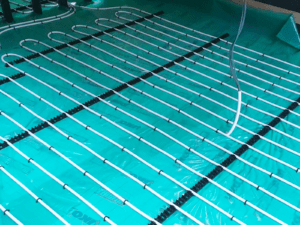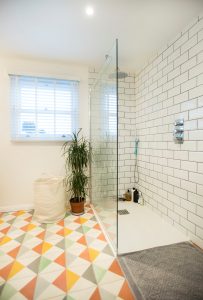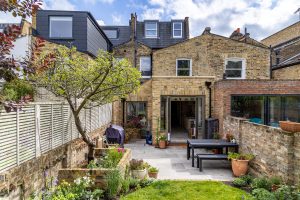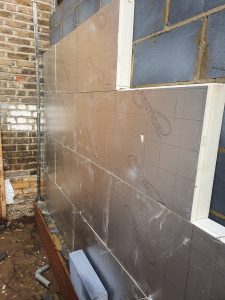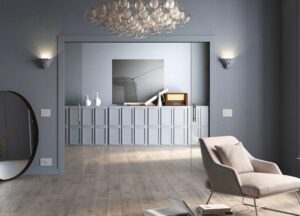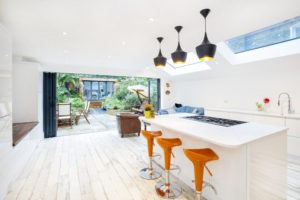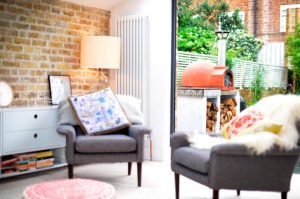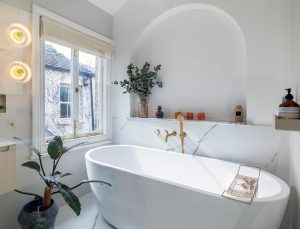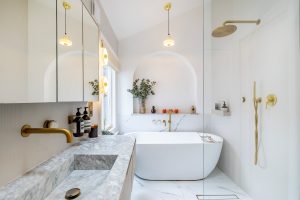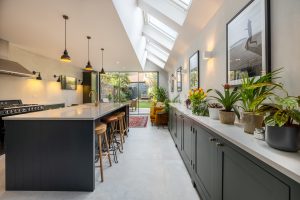Open plan extensions have revolutionised modern living, transforming how we interact with and enjoy our homes. By blending kitchen, dining, and living areas into a single, open space, these extensions maximise natural light, enhance sociability, and offer a highly versatile layout that suits many lifestyles. They not only introduce a spacious flow throughout the home but also can significantly boost property value.
However, creating an ideal open-plan space requires careful planning to strike the right balance between openness and functionality. Factors such as lighting, zoning, privacy, and noise control all play a role in crafting a space that feels cohesive, practical and welcoming. Here are some of the key things to consider when building your open plan extension.
Maximising Natural Light
Natural light is a fundamental element in any open plan space, as it creates an inviting atmosphere and enhances the perception of space. Open plan extensions are typically larger and therefore have more potential for light, but without strategic planning, they can easily feel dim or lack warmth.
To maximise natural light, consider incorporating large windows, skylights, or glass doors. Floor-to-ceiling glazing is particularly effective in open-plan extensions, helping to create an uninterrupted connection with the outdoors. Sliding or bi-fold doors can help bring in ample sunlight while providing easy access to outdoor spaces, perfect for social gatherings in warmer weather. If your property permits it, adding a roof light or lightwell in the central area of the extension can flood the space with light throughout the day. For privacy, sheer curtains or frosted glass can soften the light without blocking it completely, and strategically placing mirrors or light surfaces will reflect light and make the room feel even more spacious.
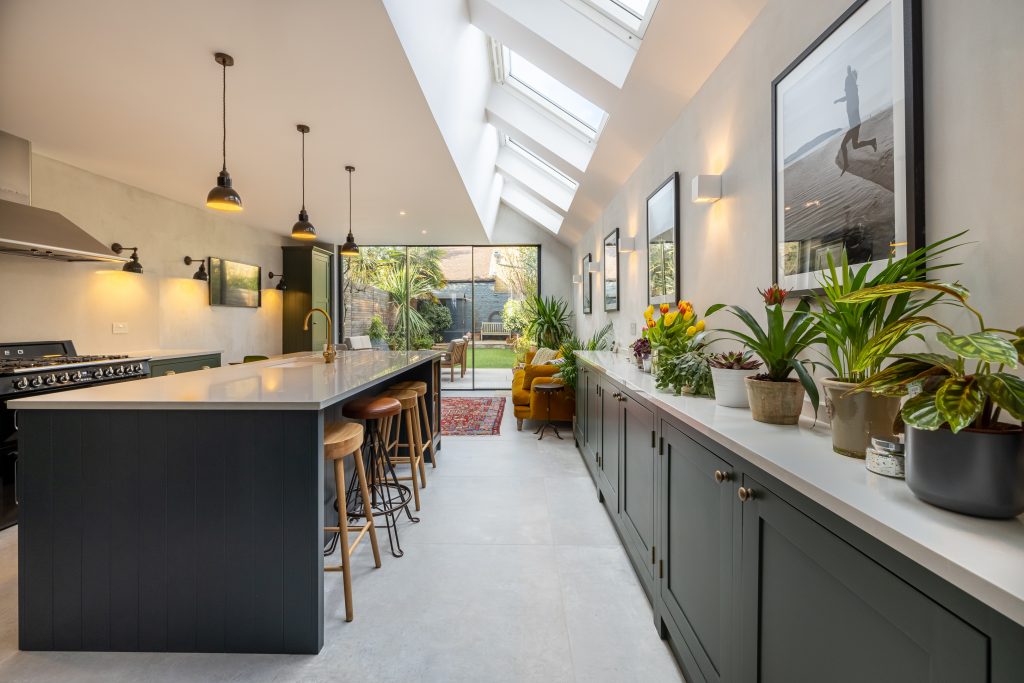
Zoning
One of the challenges in an open plan design is achieving a sense of structure without walls. Zoning is the answer—it involves creating distinct areas within the space for different activities, such as cooking, dining, and relaxing. This helps keep the space organised and visually cohesive, while maintaining the open, fluid feel.
Zoning can be done using various techniques. Rugs are a simple yet effective way to designate areas, such as a dining or seating zone, while differentiating flooring materials between the kitchen and living areas can subtly divide the space. Furniture placement is another powerful zoning tool; for example, positioning a sofa to face away from the kitchen can establish a boundary for the living area. You might also consider half-walls, open shelving, or even a strategically placed kitchen island to help define different zones while maintaining openness.
Choosing the Right Layout
A well-thought-out layout is essential to ensure that your open plan extension flows effortlessly and accommodates daily needs. Take time to map out where you want key areas—kitchen, dining, and living—to be located, considering how you and your family will move through the space.
In general, positioning the kitchen closest to the garden or outdoor area can enhance connectivity, making it easy to entertain both indoors and out. A dining area can serve as a natural bridge between the kitchen and the living room, promoting ease of movement. Ideally, the layout should allow for conversation across zones, so if you’re cooking in the kitchen, you’re not cut off from others in the living area. When it comes to open plan living, prioritise accessibility and flow, ensuring there’s enough space to navigate comfortably around key furniture pieces and that no area feels isolated.
Blending Indoor and Outdoor
Creating a seamless connection between indoor and outdoor spaces can make an open plan extension feel even more expansive. Incorporating large bi-fold or sliding glass doors is one of the most popular methods for achieving this effect, as it allows you to open the space entirely in good weather, merging the indoors with your garden or patio area.
You can also blend indoor and outdoor spaces by extending your flooring choice from the interior to the exterior or using similar materials to unify the look. For instance, decking that matches or complements the wood in your living area flooring can make the two areas feel like one continuous space. Consider adding outdoor heating or a covered patio area to extend usability throughout the year, providing a versatile transition between the two areas regardless of the weather.
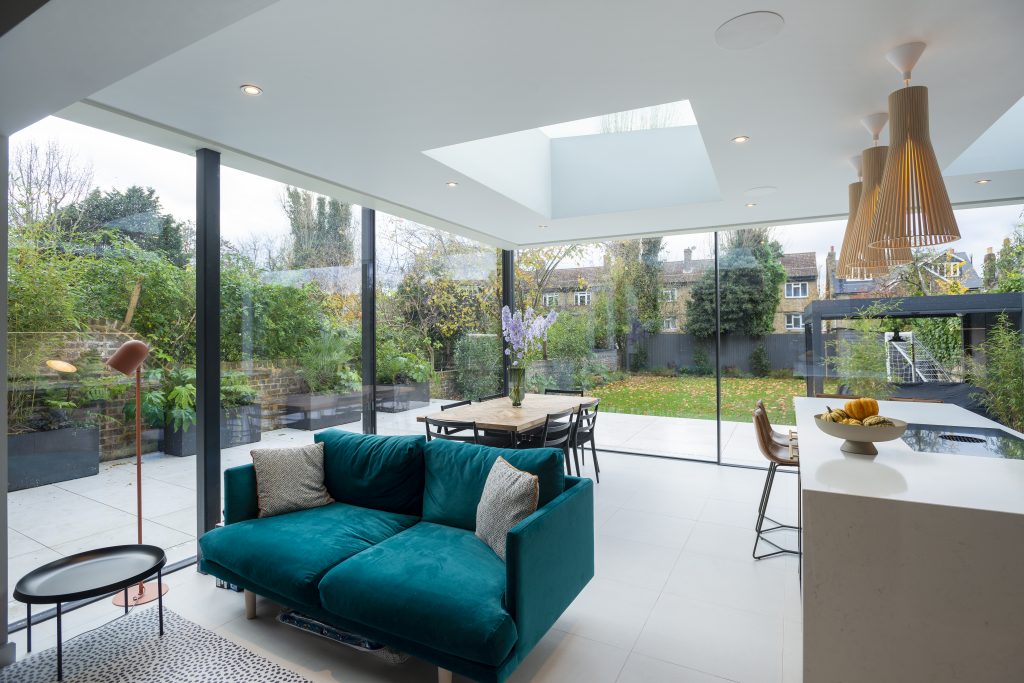
Smart Storage Solutions
Storage is essential in any open plan design to prevent vast space from becoming cluttered. The best storage solutions are often discreet, cleverly designed and strategically placed to blend seamlessly into the design.
Consider adding built-in shelving units that match the surrounding decor for a cohesive look. Kitchen islands with integrated storage can be ideal for keeping cooking utensils or crockery out of sight, while floor-to-ceiling cabinets can make use of vertical space without taking up additional floor area. In the living area, opt for modular furniture that includes hidden compartments, or add recessed storage niches that maximise capacity without disrupting the layout. The key is to make storage easily accessible but unobtrusive, so everything has a place without detracting from the aesthetic.
Standout Features
To add character and depth to an open plan extension, incorporating a few standout features can make a big impact. These elements serve as focal points that draw the eye, creating a sense of purpose and style in your open plan design.
A kitchen island, for example, can be a practical centrepiece while providing extra prep space, seating, and storage. A statement light fixture above the dining area or a unique piece of artwork in the living area can anchor each zone, giving it its own identity without breaking the flow of the space. Fireplace features or exposed brick walls can add warmth and texture, making the area feel cosy while enhancing its visual appeal. When selecting standout features, aim to strike a balance—too many bold elements can overwhelm, so choose a few highlights that complement your style and create cohesion.
Smart Home Technology
Integrating smart home technology into an open plan extension can enhance both convenience and energy efficiency. Smart lighting systems, for example, allow you to adjust the brightness in each zone according to activity and time of day, making it easy to set the perfect ambiance.
Smart thermostats can help you regulate the temperature efficiently across different areas, while app-controlled blinds and speakers provide effortless control over privacy and sound, ensuring a comfortable experience for everyone. Consider including USB charging ports or smart plugs in your design to keep devices charged and ready and think about voice-activated assistants or security systems if you want to future-proof your home. Smart technology can seamlessly enhance the functionality of your extension while reducing energy use.


